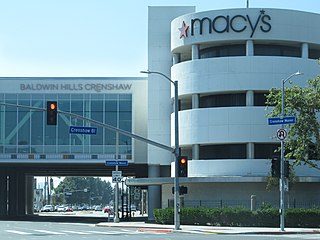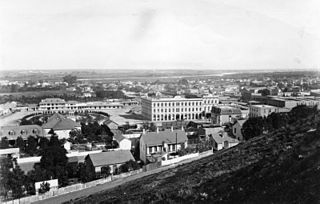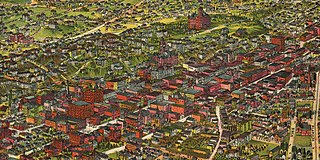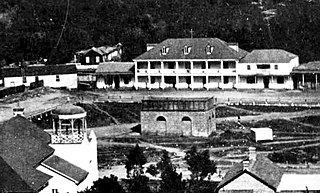
Downtown Los Angeles (DTLA) contains the central business district of Los Angeles. In addition, it contains a diverse residential area of some 85,000 people, and covers 5.84 sq mi (15.1 km2). A 2013 study found that the district is home to over 500,000 jobs. It is also part of Central Los Angeles.

Chinatown is a neighborhood in Downtown Los Angeles, California, that became a commercial center for Chinese and other Asian businesses in Central Los Angeles in 1938. The area includes restaurants, shops, and art galleries, but also has a residential neighborhood with a low-income, aging population of about 20,000 residents.

Olvera Street is a historic street in downtown Los Angeles, and a part of El Pueblo de Los Angeles Historic Monument, the area immediately around the 19th-century Los Angeles Plaza, which has been the main square of the city since the early 1820s, when California was still part of Mexico, and was the center of community life until the town expanded in the 1870s. Many of the Plaza District's historic buildings are on Olvera Street, including its oldest one, the Avila Adobe, built in 1818; the Pelanconi House built in 1857; and the Sepulveda House built in 1887.

Chinatown is a neighbourhood in Vancouver, British Columbia, and is Canada's largest Chinatown. Centered around Pender Street, it is surrounded by Gastown to the north, the Downtown financial and central business districts to the west, the Georgia Viaduct and the False Creek inlet to the south, the Downtown Eastside and the remnant of old Japantown to the northeast, and the residential neighbourhood of Strathcona to the southeast.

Hollywood Boulevard is a major east–west street in Los Angeles, California. It runs through the Hollywood, East Hollywood, Little Armenia, Thai Town, and Los Feliz districts. Its western terminus is at Sunset Plaza Drive in the Hollywood Hills and its eastern terminus is at Sunset Boulevard in Los Feliz. Hollywood Boulevard is famous for running through the tourist areas in central Hollywood, including attractions such as the Hollywood Walk of Fame and the Ovation Hollywood shopping and entertainment complex.
Like many other communities, the older Chinatowns face certain social problems. Although Chinatowns are now generally viewed and valued as tourist attractions, their earlier reputation was that of dangerous or dilapidated ghettos and slums, sites of brothels, opium dens, and gambling halls.

Beverly Center is a shopping mall in Los Angeles, California, United States. It is an eight-story structure located at the edge of Beverly Hills and West Hollywood, between La Cienega and San Vicente boulevards. Anchor tenants include Bloomingdale's and Macy's, and a Macy's men's store. The mall's dramatic six-story series of escalators offer visitors views of the Hollywood Hills, Downtown Los Angeles, and Los Angeles Westside.

The Asian-American influx to the San Gabriel Valley grew rapidly when Chinese began settling in Monterey Park, California, in the western San Gabriel Valley in the 1970s. Just east of Los Angeles, the region has achieved international prominence as a hub of overseas Chinese, or hua qiao. Although Chinese immigrants were a noteworthy presence in the establishment of Southern California from the 19th century, significant Chinese migration to suburban San Gabriel Valley coincided with a trend of white out-migration from the 1970s onward. This opened an opportunity for middle-class Asian Americans to begin settling in the San Gabriel Valley.
Plaza West Covina is a large regional shopping mall in West Covina, California, owned by the Starwood Capital Group. Its anchor stores are Macy's, JCPenney, XXI Forever, Nordstrom Rack, Best Buy, and Gold's Gym with one vacant space last occupied by Sears. Westfield America, Inc., a precursor to Westfield Group, acquired the shopping center in 1998 and renamed it "Westfield Shoppingtown West Covina", dropping the "Shoppingtown" name in June 2005. In October 2013, the Westfield Group sold the mall to Starwood Capital Group and the mall is now managed by Pacific Retail Capital Partners.
Los Angeles Street, originally known as Calle de los Negros or Alley of the Black People, is a major thoroughfare in Downtown Los Angeles, California, dating back to the origins of the city as the Pueblo de Los Ángeles.

Baldwin Hills Crenshaw Plaza is a shopping mall located in the Baldwin Hills neighborhood of Los Angeles, California. This was one of the first regional shopping centers in the United States built specifically for the automobile. Two anchor buildings, completed in 1947, retain their original Streamline Moderne style. Since the mid-1960s, the mall has become a major economic and cultural hub of surrounding African American communities which include a spectrum of socioeconomic classes.

El Pueblo de Los Ángeles Historical Monument, also known as Los Angeles Plaza Historic District and formerly known as El Pueblo de Los Ángeles State Historic Park, is a historic district taking in the oldest section of Los Angeles, known for many years as El Pueblo de Nuestra Señora la Reina de los Ángeles del Río de Porciúncula. The district, centered on the old plaza, was the city's center under Spanish (1781–1821), Mexican (1821–1847), and United States rule through most of the 19th century. The 44-acre park area was designated a state historic monument in 1953 and listed on the National Register of Historic Places in 1972.

Hill Street is a major north–south thoroughfare in Los Angeles, measuring 4.8 miles (7.7 km) in length. It starts on Martin Luther King, Jr. Boulevard near the campus of USC, and passes north through Downtown Los Angeles, past such landmarks as Pershing Square, the Subway Terminal Building, Angels Flight, Fort Moore and Chinatown. Hill Street merges with the Arroyo Seco Parkway near Dodger Stadium.

Chinatowns are enclaves of Chinese people outside of China. The first Chinatown in the United States was San Francisco's Chinatown in 1848, and many other Chinatowns were established in the 19th century by the Chinese diaspora on the West Coast. By 1875, Chinatowns had emerged in eastern cities such as New York City, Boston, and Philadelphia. The Chinese Exclusion Act of 1882 barred Chinese immigration to the United States, but the Magnuson Act of 1943 repealed it, and the population of Chinatowns began to rise again. In the 2010s, the downturn in the U.S. economy caused many Chinese Americans to return to China.

Historically there has been a population of Chinese Americans in Los Angeles and the Los Angeles Metropolitan Area. As of 2010, there were 393,488 Chinese Americans in Los Angeles County, 4.0% of the county's population, and 66,782 Chinese Americans in the city of Los Angeles.

Sonoratown was a neighborhood of downtown Los Angeles, California.

The late-Victorian-era Downtown of Los Angeles in 1880 was centered at the southern end of the Los Angeles Plaza area, and over the next two decades, it extended south and west along Main Street, Spring Street, and Broadway towards Third Street. Most of the 19th-century buildings no longer exist, surviving only in the Plaza area or south of Second Street. The rest were demolished to make way for the Civic Center district with City Hall, numerous courthouses, and other municipal, county, state and federal buildings, and Times Mirror Square. This article covers that area, between the Plaza, 3rd St., Los Angeles St., and Broadway, during the period 1880 through the period of demolition (1920s–1950s).

The Lugo Adobe also called the Vicente Lugo Adobe or Casa de Don Vicente Lugo was a house in the city of Los Angeles, located on the east side of the Los Angeles Plaza at 512–524 N. Los Angeles Street.

Retail in Southern California dates back to its first dry goods store that Jonathan Temple opened in 1827 on Calle Principal, when Los Angeles was still a Mexican village. After the American conquest, as the pueblo grew into a small town surpassing 4,000 population in 1860, dry goods stores continued to open, including the forerunners of what would be local chains. Larger retailers moved progressively further south to the 1880s-1890s Central Business District, which was later razed to become the Civic Center. Starting in the mid-1890s, major stores moved ever southward, first onto Broadway around 3rd, then starting in 1905 to Broadway between 4th and 9th, then starting in 1915 westward onto West Seventh Street up to Figueroa. For half a century Broadway and Seventh streets together formed one of America's largest and busiest downtown shopping districts.

Old Chinatown, or original Chinatown, is a retronym that refers to the location of a former Chinese-American ethnic enclave enforced by legal segregation that existed near downtown Los Angeles, California in the United States from the 1860s until the 1930s. Old Chinatown included the former Calle de los Negros and extended east across Alameda Street to Apablasa, Benjamin, Jeannete, Juan, Marchessault, and Macy Streets. This Chinatown was at its commercial and communal peak between 1890 and 1910.
![Ricsha [sic] ride concession, China City (1938) RicshaRide25c..jpg](http://upload.wikimedia.org/wikipedia/commons/thumb/5/53/RicshaRide25c..jpg/220px-RicshaRide25c..jpg)















